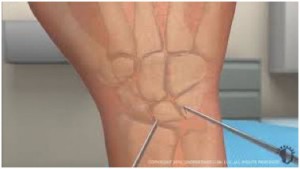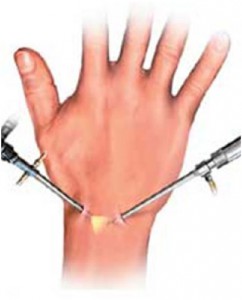Wrist Arthroscopy
 Wrist arthroscopy is a surgery that allows a doctor to see the inside of a joint. It is performed after a patient sustains an injury such as a fall or a twisting of the wrist and is experiencing pain, clicks or swelling. These symptoms may mean there is an internal problem of the wrist. Arthroscopy is often the best way of directly looking at the injury and repairing it. The procedure can be used to help align fractures of the wrist, remove some ganglions of the wrist, wash out infection, or remove excess joint lining associated with inflammation from conditions like rheumatoid arthritis.
Wrist arthroscopy is a surgery that allows a doctor to see the inside of a joint. It is performed after a patient sustains an injury such as a fall or a twisting of the wrist and is experiencing pain, clicks or swelling. These symptoms may mean there is an internal problem of the wrist. Arthroscopy is often the best way of directly looking at the injury and repairing it. The procedure can be used to help align fractures of the wrist, remove some ganglions of the wrist, wash out infection, or remove excess joint lining associated with inflammation from conditions like rheumatoid arthritis.
Preparation for Wrist Arthroscopy
Your health care provider will talk to you about how to prepare for surgery. He may tell you not to eat or drink anything after midnight on the day of your surgery. He will tell you what medications to take or not take on the day of your surgery before surgery; you will need to obtain clearance from your regular doctor if you have medical problems. You may be required to obtain some basic tests for screening before the surgery. Basic blood tests, a chest x-ray, and an EKG may be required depending on your health.
 Surgical Procedure
Surgical Procedure
During the procedure, a small camera fixed to the end of a narrow tube is placed through a small cut in the skin directly into the back of the wrist joint. The image is projected onto a television screen for better viewing. Several small cuts are used to allow the surgeon to place the camera in a number of positions to see the cartilage of each bone, the ligaments and the joint lining called synovium.
Recovery
After your surgery, you will be placed in a bandage that may prevent wrist motion. This will protect the area and provide pain relief. Arthroscopy most likely does not require an overnight hospital stay. Fingers should move freely, and finger movement is often encouraged to limit swelling and stiffness. Your surgeon will provide instructions on caring for your wound, therapy, safe activities and any work or exercise restrictions. Elevating the wrist is important to prevent swelling and pain after surgery.
Risks
As with any surgical procedure, complications can occur, some possible complications may include, but are not limited to the following:
- Infection
- Damage to nerves, tendons or cartilage
- Stiffness or loss of joint motion
Stiffness can be addressed post-surgery with rehabilitation.
